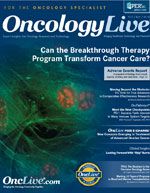Leading Checkpoint Researcher Optimistic About New Targets
Thomas F. Gajewski, MD, PhD, discusses how the field of immune checkpoints is expanding beyond PD-1 and CTLA-4.
Thomas J. Gajewski, MD, PhD
Thomas J. Gajewski, MD, PhD, is among the oncology field’s original proponents of targeting immune checkpoints as an anticancer strategy. His research focuses on the mechanisms underlying T-cell activation and how this can be applied to clinical development of drugs that promote antitumor immunity, with a particular focus on melanoma.
Q: How is the field of immune checkpoints expanding beyond PD-1 and CTLA-4?
Gajewski leads the immunology program at the University of Chicago Cancer Center and is the institution’s director of melanoma oncology. A past president of the Society for Immunotherapy of Cancer, Gajewski currently serves a co-leader of a National Cancer Institute task force on immunotherapy.This is an exciting time for the field of cancer immunotherapy. Now that we know that CTLA-4 and PD-1 are inhibitory receptors that suppress the function of activated T cells, a more detailed analysis of dysfunctional T cells in the tumor microenvironment has identified a range of additional inhibitory receptors expressed. These include LAG-3, TIM-3, and TIGIT, among others. Extrinsic to the T cells, these tumors also express the tryptophan-catabolizing enzyme indoleamine- 2,3-dioxygenase, which also contributes to T-cell dysfunction. And Foxp3+ regulatory T cells (Tregs) are also present in T cell-infiltrated tumors and known to inhibit T cells. This cataloguing has led to a wide range of inhibitory factors to attempt to block pharmacologically, in the hopes of restoring T-cell function and promoting immune-mediated tumor regression as a cancer therapeutic.
Q: Which of these “new” checkpoints is most promising?
Q: How does the development of these newer agents compare with PD-1/CTLA- 4-targeting therapies?
One additional point: In addition to immune inhibitory factors, recent work has indicated that dysfunctional T cells within the tumor microenvironment also express a range of positive costimulatory receptors. These include 4-1BB, OX40, and ICOS, among others. These observations raise the possibility that administration of agonistic antibodies against these molecules could also “push” T cells into becoming more functional at the tumor site, in addition to the “pull” mediated by checkpoint blockade.Each one of these factors is quite interesting and attractive from the drug development perspective. The biology of these molecules has been fairly well delineated, and preclinical data has supported their functional role in antitumor immunity. Agents targeting these pathways are in various stages of clinical development. Perhaps furthest along is a small molecule IDO inhibitor, which in phase I clinical trial testing looks promising when combined with either anti-CTLA-4 or anti-PD-1 antibodies.In general, the side effect profiles of all immunotherapy agents include immune-related adverse events such as a skin rash. Such side effects seem most frequent with anti-CTLA-4 antibody and are less frequent with anti-PD-1 agents.
Q: Please discuss the importance of combination therapy in this setting.
The clinical experience with the newer drugs is still early, but I think we should expect some degree of immune-like side effects with those agents as well. The early data combining the IDO inhibitor have suggested that a dosing scheme is feasible that does not substantially increase the side effect profile seen with either the anti-CTLA- 4 or anti-PD-1 partner antibody. So it might be possible to advance combination therapies that have quite acceptable toxicity profiles.Clinically, not every patient who is predicted to be capable of responding to anti-PD-1 therapy does so, and other immune regulatory mechanisms can compensate. Therefore, a high priority is being placed on combination therapies.
Q: What are the most significant challenges in targeting these new checkpoints?
In preclinical models, the combination of two immune checkpoint agents together can have synergistic antitumor activity, in many studies causing complete tumor elimination. The first anti-CTLA-4/ anti-PD-1 combination was recently approved by the FDA for the treatment of patients with advanced melanoma, although the side effect profile is significant and requires careful management. Other combinations are similarly advancing in phase I testing, including examination of whether agonistic antibodies against costimulatory receptors (eg, 4-1BB, OX40) can improve efficacy combined with blocking antibodies against inhibitory receptors like PD-1. The next several years may witness one or more of these newer combinations advancing to later-phase clinical trial testing.A major critical question that remains in the field is why some patients fail to respond at all to immunotherapies such as anti-PD-1. Thus, an increased focus on the treatment failures is needed.
We recently have uncovered two processes that impact on therapeutic efficacy significantly. First, some oncogene pathways activated within subsets of tumors can result in exclusion of the immune response from the tumor microenvironment. The first of these fully characterized is the Wnt/beta- catenin pathway, which argues that new drugs targeting the beta-catenin pathway should be developed to improve immunotherapy efficacy.1
Second, the composition of the intestinal microbiome has been found to have a profound impact on antitumor immunity, which raises the possibility that probiotics might be developed to optimize antitumor immune responses and maximize anti-PD-1 efficacy.2 Future work in this area should identify the full range of molecular mechanisms leading to immunotherapy resistance in a wide range of cancer types, thereby identifying novel targets for development of new therapeutic interventions.
References
- Spranger S, Bao R, Gajewski TF. Melanoma-intrinsic β-catenin signalling prevents anti-tumor immunity. Nature. 2015;523(7559):231-235.
- Sivan A, Corrales L, Hubert N, et al. Commensal Bifidobacterium promotes antitumor immunity and facilitates anti-PD-L1 efficacy. Science. 2015;350(6264):1084-1089.




